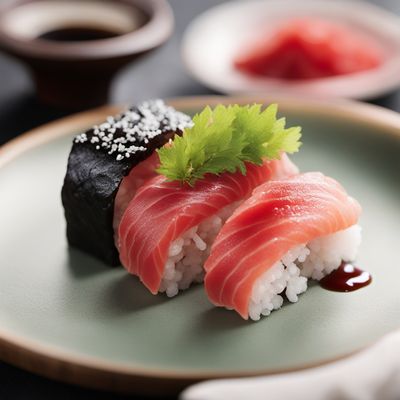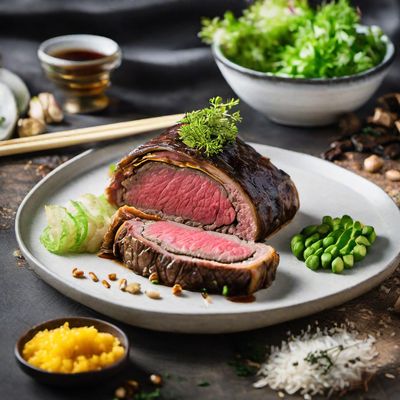
Ingredient
Wasabi roots
The Fiery Green Elixir: Unveiling the Secrets of Wasabi Roots
Wasabi roots, also known as Japanese horseradish, are small, knobby rhizomes with a pale green color. They have a fibrous texture and are typically grated into a paste before being used. The flavor of wasabi roots is pungent and fiery, with a sharp, peppery kick that quickly dissipates, leaving a refreshing and slightly sweet aftertaste. Its vibrant green color adds visual appeal to dishes, making it a favorite among chefs and food enthusiasts.
Origins and history
Wasabi roots have a rich history dating back centuries in Japan. They are native to the mountainous regions of Japan, where they grow naturally along riverbanks. Wasabi has been cultivated in Japan since the 10th century and was initially used for medicinal purposes due to its antibacterial properties. Over time, it became a popular condiment and ingredient in Japanese cuisine, particularly for sushi and sashimi.
Nutritional information
Wasabi roots are low in calories and fat, making them a healthy addition to meals. They are a good source of vitamin C, dietary fiber, and antioxidants, which contribute to overall health and well-being.
Allergens
Wasabi roots are not known to be allergenic, but individuals with a sensitivity to horseradish or mustard may experience a similar reaction.
How to select
When selecting wasabi roots, look for firm, unblemished rhizomes with a vibrant green color. Avoid roots that are soft, discolored, or have moldy spots. The best-quality wasabi roots will have a strong aroma, indicating their freshness.
Storage recommendations
To maintain the freshness and quality of wasabi roots, store them in a cool, dark place, such as the refrigerator. Wrap them in a damp paper towel or place them in a sealed container to prevent them from drying out. Properly stored, they can last for up to two weeks.
How to produce
Wasabi roots can be challenging to grow, requiring specific conditions such as cool temperatures, shade, and moist soil. They thrive in mountainous regions with ample water supply. It is recommended to consult with experts or nurseries specializing in Japanese plants for guidance on growing wasabi roots.
Preparation tips
To prepare wasabi roots, wash them thoroughly and peel off the outer layer. Grate the roots using a traditional Japanese grater or a fine grater to create a smooth paste. It is best to grate the roots just before using to preserve their flavor and potency. Wasabi paste can be used as a condiment for sushi, sashimi, or mixed into sauces and dressings for an added kick.
Substitutions
Horseradish can be used as a substitute for wasabi roots, as it offers a similar pungent flavor and heat. However, it lacks the distinct sweetness and vibrant green color of wasabi.
Culinary uses
Wasabi roots are most commonly used in Japanese cuisine, particularly for sushi, sashimi, and other seafood dishes. They can also be incorporated into sauces, dressings, and marinades to add a spicy kick. Wasabi-flavored snacks and condiments, such as wasabi peas and mayonnaise, have gained popularity in recent years.
Availability
Wasabi roots are primarily cultivated in Japan, particularly in regions such as Shizuoka and Nagano. They are also grown in other countries with suitable climates, including the United States, New Zealand, and Taiwan.
More ingredients from this category

Greater galangal roots
The Aromatic Spice: Unveiling the Secrets of Greater Galangal Roots

Fingerrot roots
The Exotic Spice

Orris root
The Fragrant Rhizome of Elegance

East Indian galangal
The Exotic Spice of East India

Ginger roots
The Zesty Wonder: Unleashing the Power of Ginger Roots

Galangal roots
The Exotic Spice: Galangal Roots

Lesser galangal roots
The Aromatic Spice
Recipes using Wasabi roots » Browse all

Chutoro Nigiri Sushi
Delicate Harmony: Chutoro Nigiri Sushi

Tobiko Explosion Gunkan Maki
Oceanic Delight Gunkan Maki

Aji Nigiri Sushi
Ocean Delight Nigiri Sushi

Japanese-style Margherita Pizza
Umami Fusion: Japanese-inspired Margherita Pizza

Japanese-inspired Tapas
Umami Fusion: Japanese-inspired Tapas with a Spanish Twist

Arab-style Sushi Rolls
Middle Eastern Fusion: Arab-inspired Sushi Rolls

Hirame Nigiri Sushi
Delicate Flavors of the Sea: Hirame Nigiri Sushi

Otoro Nigiri Sushi
Heavenly Delights: Otoro Nigiri Sushi

Molecular Sushi
Sushi Reimagined: A Molecular Gastronomy Twist

Hamaguri Nigiri Sushi
Ocean Delight Nigiri Sushi

New York-Style Pizza with a Japanese Twist
Sakura Pizza

Japanese-style Beef Wellington
Sakura Beef Wellington: A Fusion of British and Japanese Flavors